Black Information, Memory and Justice: Tracing Historical Relational Networks
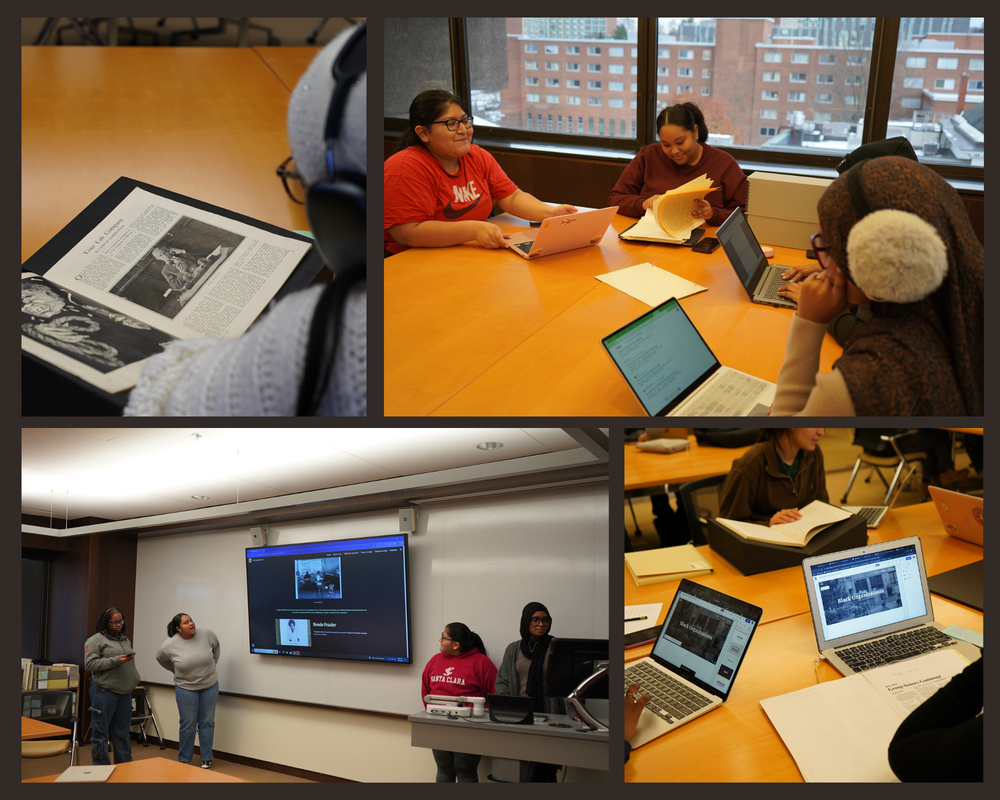
by Dr. LaVerne Gray, Iman Jamison, and Jana Rosinski
For the fall 2024 semester, a group of undergraduate and graduate students from African American Studies and Information Studies were brought together for a unique learning experience with Dr. LaVerne Gray, Assistant Professor in the School of Information Studies and 2023-2024 SCRC Faculty Fellow, in the class “IST/AAS 300/600: Black Information, Memory, and Justice.”
The class explores the Black Experience historically from an informational perspective. It examines information collectives, history, memory, and justice activities. Students were asked to consider Black library and learning traditions, formal and informal information networks, information embodiment, informational resistance activities and the role social justice plays in the organizing and development of community consciousness. With the support of Jana Rosinski, SCRC Instruction and Education Librarian, and Iman Jamison, SCRC Graduate Instructional Assistant and Library Science MA student, Dr. Gray and her students moved through time, space, and place, reading in-between and beyond lines of correspondence, personal photographs, scrapbooks, newspapers, magazines, and Black art and culture journals to re-create communities through the traces of lives lived as captured by these materials. On working with the class over the course of the semester, Iman enjoyed being a part of shaping the students’ exploration of SCRC’s printed materials and manuscript collections to hone their sub-interests in Black information studies:
“Each student had different interests that they were bringing to the class, and I enjoyed curating materials for them to further their research and create their final projects that embodied all their hard work. The class was a beautiful way to highlight Black community networks in different realms of society and history through archival practices, and Dr. Gray encouraged the students to use every resource available to them to paint a larger contextual picture of Black historical figures, organizations, and movements.”
The culmination of the class was a digital project, Curating a Mini-Virtual Narrative Exhibit on Black Information, in which students applied the skills of archival and genealogical research that they learned throughout the semester from Dr. Gray and through time exploring materials at SCRC, the SU Art Museum’s fall exhibition featuring the work of renowned photographer, writer, poet, musician and composer Gordon Parks in the exhibition Homeward to the Prairie I Come, as well as digital repositories of historical import. Students, working independently and in groups based on shared interest, produced Google sites to tell a narrative on Black information, memory, and justice through a selection of artifacts and manuscripts as well as contextualizing secondary source research. Their narratives provided insight into historical contexts from the mid-nineteenth century through the 1990s with attention to a complex network of factors—from place, space, beliefs, an array of political, economic, social, and cultural ideologies and societal infrastructures—centered on individuals in relation to their community, sometimes local to the level of familial, other times as far reaching as connected diasporas across continents.
Here, we provide a brief overview of each narrative exhibit.
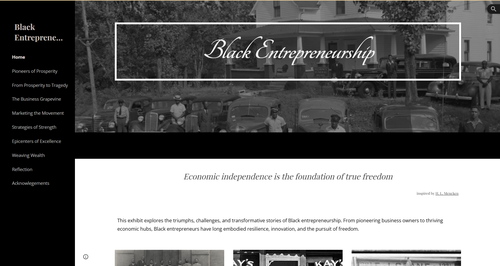
Screenshot of the Black Entrepreneurship project site.
Celes Buffard’s final project explored “the triumphs, challenges, and transformative stories of Black entrepreneurship” through stories of Black entrepreneurs such as Madame CJ Walker, economic hubs such as Black Wall Street, and networks of information in marketing and business advertisements in Black publications such as The Crisis.
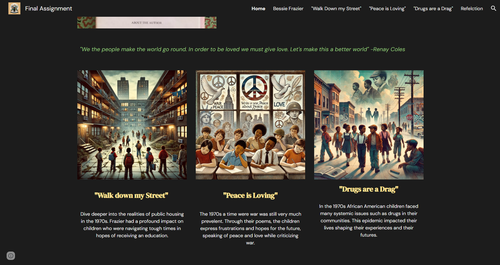
Screenshot of the Bessie Frazier project site.
Amanda Lynch, Kyana Lora, Sarhia Rahim, and Nayeli Perez’s final project focused their research on “the life and impact of Bessie Frazier,” an author and educator in New Jersey during the 1970s, and the themes explored by her middle school students in an unpublished manuscript of original art, photography, poetry, and prose housed in the Grove Press Records.
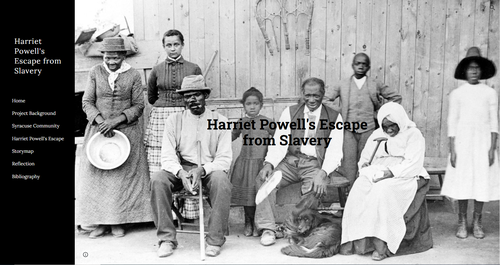
Screenshot of the Harriet Powell project site.
Carol Weinfeld focused her final project on the story of Harriet Powell, her escape from enslavement, and the network of abolitionists that lived in Syracuse, New York throughout the 19th century. Her goal was to build a more complete picture of abolitionist networks in place at the time using archival materials in the Harriet Powell Collection coupled with other archival resources from the Onondaga Historical Association.
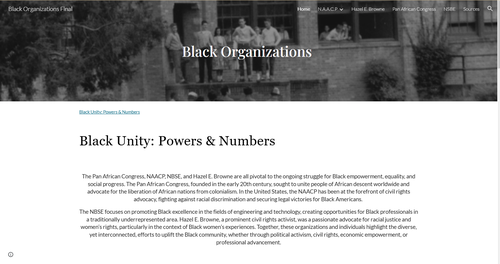
Screenshot of the Black Organizations project site.
Anayah Conyers, Zaria Kirkland, Mari Bourne, and Justina Williams chose to highlight Black organizations such as the Pan-African Congress, the NAACP (National Association for the Advancement of Colored People), NSBE (National Society of Black Engineers), and members of the Divine Nine (the collective of nine historically African American sororities and fraternities), such as Hazel E. Browne, in order to highlight their contributions to the “ongoing struggle for Black empowerment, equality, and social progress.” Archival materials highlighted in their project include the periodical The Crisis and the National Society of Black Engineers Records.
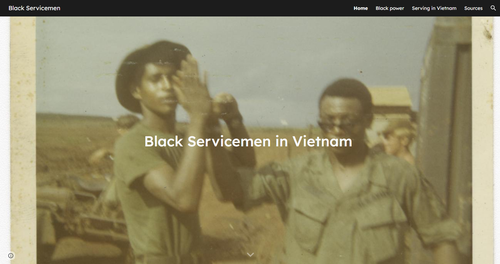
Screenshot of the Black Servicemen in Vietnam project site.
Josue Melgar focused his final project on Black servicemen during the Vietnam War using photos from the Black Serviceman’s Photograph Archive collection. His goal was to contextualize the struggle Black men endured when joining branches of the U.S. military during the height of the Black Power Movement and ongoing anti-war sentiments from the community, as well as honor the service and sacrifice of African American men.

Screenshot of the Pan-Africanism and Cultural Resistance project site.
Jonathan Muhindo’s final project examined Pan-Africanism and cultural resistance as the response to imperialism and the legacy of colonial interactions. Making use of the Syracuse University Publication Collection, specifically Braintrust of the Empire, as well as The Journal of Black Poetry, he focused on reframing Africa and the African diaspora beyond “a single story.”
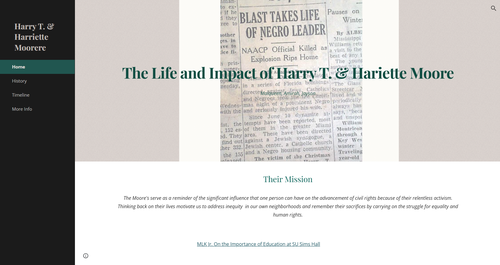
Screenshot of The Life and Impact of Harry T. & Harriette Moore project site.
Amirah Britt, Maiqueen Cordero, and Jayson Strickland used an assortment of print materials to highlight the story of Harry T. and Harriette Moore, a Black couple who were pioneering civil rights activists in Florida in the 1940s and early 1950s, who were murdered when their home was bombed. Their project focuses on the couple’s story of activism during the Jim Crow era. Printed materials used include a pamphlet titled Jim Crow Murder of Mr. and Mrs. Harry T. Moore: New Dangers and New Tasks Facing the Negro Struggle and Toni Morrison’s The Black Book.
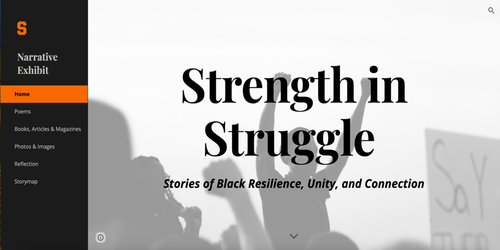
Screenshot of the Strength in Struggle: Stories of Black Resilience, Unity, and Connection project site.
Destiny Perdomo, Frazia Jan, and Richell Perez focused their research on a selection of publications and figures that were central to the Black Arts in key historical moments—the Harlem Renaissance and the Black Power and Black Nationalism Movements. The spaces of Black-owned and -operated publications were crucial in providing platforms and networks of connection for the centering of the full spectrum of Black identity and intellectualism, often counter to the history being documented or outwardly omitted through media.
In preparation for the final project, which brought together a number of collections in relation with one another, students conducted a deep analysis of an artifact or group of related artifacts found in the SCRC that represented an element of the Black Information experience to give that artifact lived context beyond the archival record.
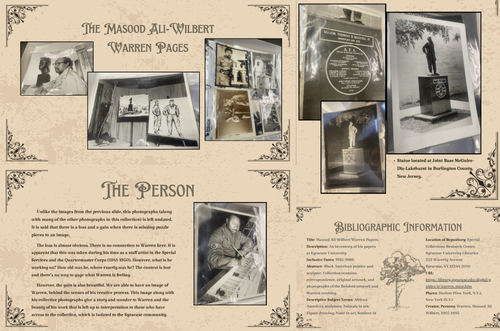
Collage of slides from the presentation on Masood Ali-Wilbert Warren Papers.
For this particular assignment, Loralei Gonzalez chose the Masood Ali Wilbert Warren Papers to decipher meaning behind his work as a Black American painter, sculptor, and veteran—having served as both a staff artist and combat artist in the Army and Air Force. Through her work with photographs and sketches in the collection, along with her secondary research, she learned how absent Masood Ali-Wilbert Warren is to the historical record and highlights the importance of archival collections such as these to keep his memory alive.
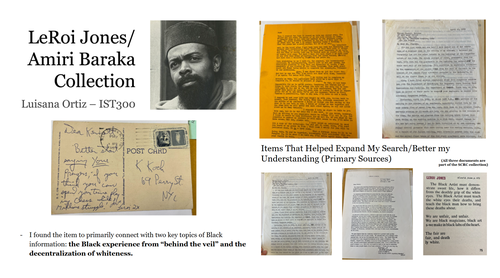
Collage of slides from the presentation on the LeRoi Jones (Amiri Baraka) Collection.
Luisana Ortiz chose to focus her research on the LeRoi Jones (Amiri Baraka) Collection, specifically an evocative postcard sent by Amiri Baraka to a contemporary white poet in New York City that called attention to personal political in/action. Through secondary research about Baraka, along with comparative analysis of other articles of correspondence in the collection, questions about how Baraka’s artistic activity during his life and his legacy now as a political and cultural figure in the Black Arts, in critical intellectual scholarship about the arts, and in broader experimental and boundary-pushing poetry and drama spanning the 1960s to the 2010s were explored.
